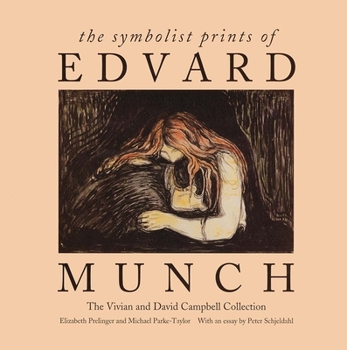The Symbolist Prints of Edvard Munch: The Vivian and David Campbell Collection
Select Format
Select Condition 
Book Overview
Edvard Munch is one of the twentieth century's greatest printmakers, and his works--particularly The Scream and Madonna--have made their way into the popular culture of our time. This handsome book considers Munch's graphic work through the lens of an extraordinary private collection that includes outstanding impressions of virtually every one of his major prints, along with alternate versions and early states. The book underscores the technically experimental nature of Munch's Symbolist prints and demonstrates the great themes of love and death that characterize his fin de si?cle imagery. Elizabeth Prelinger discusses Munch as a Symbolist printmaker, providing background on Munch as a graphic artist and exploring how he devised innovative methods to fuse technique and meaning in his Symbolist themes. Michael Parke-Taylor reconstructs the reception of Munch's art in America, tracing a reputation that continues to grow a half century after the artist's death. Peter Schjeldahl poetically evokes Munch's work and accounts for the artist's rock star-like career then and now, and tells how Munch has entered popular consciousness and how he is relevant to a contemporary audience. These essays are accompanied by a detailed catalogue of the fifty-eight prints in the collection, as well as reproductions of the paintings that relate to the prints and many documentary and comparative illustrations.
Published in association with the Art Gallery of Ontario, Toronto
Published in association with the Art Gallery of Ontario, Toronto
Format:Hardcover
Language:English
ISBN:0300069529
ISBN13:9780300069525
Release Date:September 1996
Publisher:Yale University Press
Length:246 Pages
Weight:3.25 lbs.
Dimensions:1.1" x 10.1" x 10.4"
Customer Reviews
2 ratings
La douleur, la couleur et le criard
Published by Thriftbooks.com User , 21 years ago
Il montrait sa soeur Sophie qui mourait jeune, entouree de toute la famille. Mais il montrait chacun a l'age qu'il avait a l'epoque de la peinture, et non pas a la mort de la jeune fille. Car la douleur durait a jamais et unifiait toute la famille pour toujours. Puis avec des tetes d'une femme et d'un homme, gravees et multicolorees, il cessait de suivre le style repandu des japonais de faire une seule couleur d'un seul troncon de bois. Son prefere de tout son oeuvre etait Sick Child II, en tant que sa premiere lithographie en couleur. Mais son Scream est le plus reconnu, en tant que l'image la plus frappante du 20eme siecle.
The Print and the Darkness
Published by Thriftbooks.com User , 23 years ago
He was bound determined not to paint people reading and women knitting, but instead to show people who breathed emotions into his darkly suggestive prints. "Death in the sickroom" showed family members at the ages when they were painted, not when his sister Sophie died; it expressed unity in grief as one of death's longlasting effects by seemingly overlapping planes flowing together across bleakly empty areas, starkly B & W contrasts, and stiffly posed mourners frozen in misery. "The mirror" heads of a disembodied man and woman was his first woodcut to give up the Japanese method of printing each color with a separate woodblock; instead, he jigsawed blocks into pieces according to compositional design, linked each piece with a different color, and put everything back together into a multicolored print. He considered his "Sick child II" his most important print: his first color lithograph, it focused on the diseased upper chest and the head in profile facing right against a large pillow in order to gaze with tragically meditative resignation into the flatly patterned looming void on the far right. However, his "Scream" became the most compelling image for the late twentieth century: it expressed terror before the universe by powerfully decorative lines reverberating through the starkly opposed black lines and bleakly white voids of pulsing land and sky. Elizabeth Prelinger and Michael Parke-Taylor have applied reader-friendly illustrations and text to their catalog of the Vivian and David Campbell exhibition. Their SYMBOLIST PRINTS OF EDVARD MUNCH goes down good with PROGRESSIVE PRINTMAKERS by Warrington Colescott and Arthur Hove, PRINTS AND PRINTMAKING by Antony Griffiths, EDVARD MUNCH by Josef Paul Hodin, and THE PRINT IN THE WESTERN WORLD by Linda C Hults.





